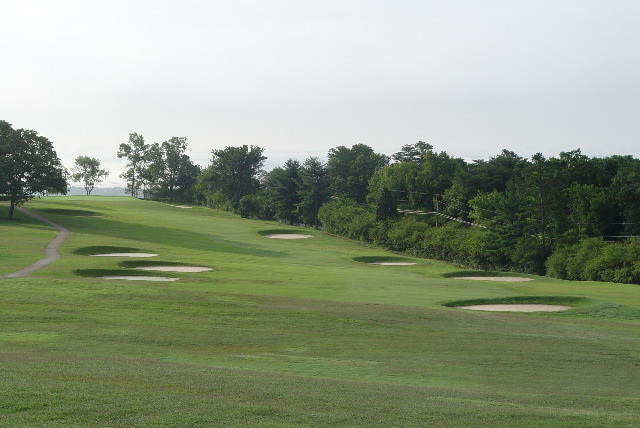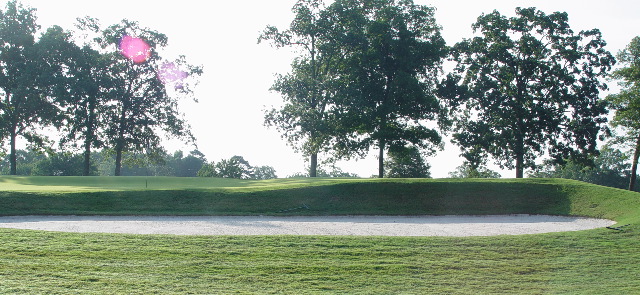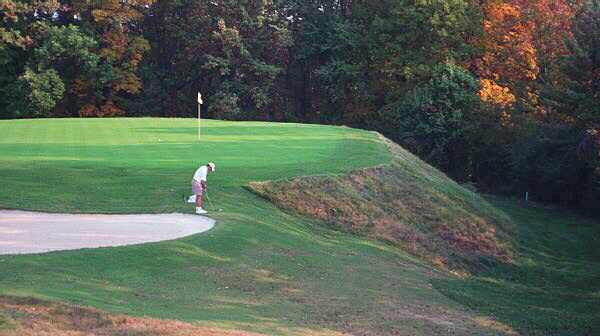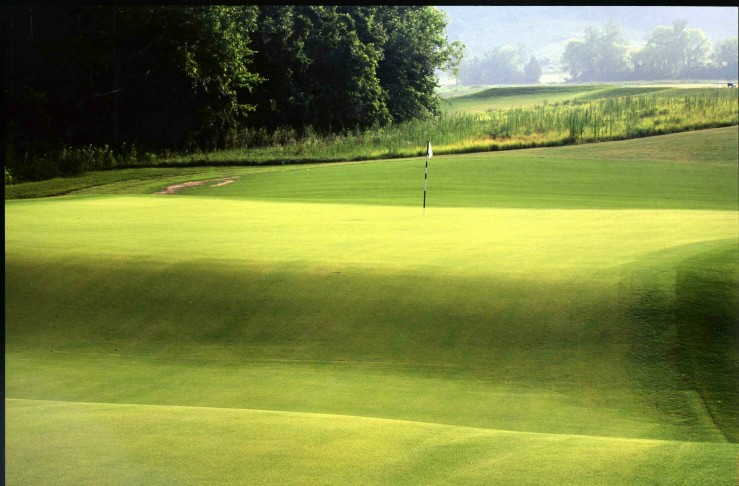Feature Interview with Mark Stovall and Scott Wicker May, 2004
Mark Stovall is the Green Keeper at Lookout Mountain Golf Club in Lookout Mountain, Georgia just outside of Chattanooga, Tennessee. A keen student of classic golf course architecture, Stovall has been at Lookout since January, 2000 and has helped to oversee the restoration of the classic Raynor features to this golf course, such as supervising the tree removal and planting of natural areas as indicated by Raynor’s original plans. Stovall has always been interested in golf course maintenance, starting out on the crew at Fulton Country Club in May 1987 and graduating with a Bachelor of Science in Agronomy specializing in Turfgrass Management at Mississippi State University in 1993.
1) Describe the property with which Raynor and Banks had to work.
Lookout Mountain Golf Club sits atop Lookout Mountain on a broad expanse of plateau land, at an elevation of 1800 feet. A founding member Garnet Carter recalled the meetings with Raynor in his book, ‘The Crest Lodge, Lookout Mountain and Fairyland’. Raynor’s first impression of the land Carter showed him was favorable, but he wasn’t overwhelmed. So Raynor set out on foot, exploring and envisioning. His work took days, but his patience was rewarded. The grotesque rock formations in the area fascinated him and the view from the brow thrilled him. If only some of the ground were level enough. Sauntering on, he stepped into a clearing and stopped with a gasp of satisfaction. Before Raynor stretched a broad expanse of plateau land, partly enclosed by rugged cliffs, nature’s handiwork of a million years of upheaval by earthquakes and glacial flow. A sight such as he had often pictured and hoped to find, a challenge and an opportunity he was quick to seize.
2) What was the original cost of Fairyland (Lookout Mountain Golf Club)?
The cost of construction came in at a little over $400,000. That number came very close to Yale University’s cost of $450,000. Only the pumping and filling operations for the incredible engineering feat at Lido ($800,000) surpassed that of Yale and Lookout Mountain in the days before 1930.
3) Lookout was originally termed a ‘links in the sky’ – what was meant by this expression? What work has been done to make the course true to that vision?
It has been called a mountain links course, as contrary as that sounds. You’ve got several of the design elements of a links course, with a mountain setting. On a links course, you battle the elements, it is the same here. C.B. McDonald said the most valuable asset a golf course can have is wind. There are a lot of windy days up here! During the past six years there have been numerous trees removed throughout the course. We have opened up the golf course in between the holes to expose some of the contours of the course. This work has allowed wind to become a bigger part of the experience at Lookout Mountain. Also, in 1998 Brian Silva using Raynor’s plans completed a unique bunker restoration and restored two greens to their original design.

Looking down the 2nd fairway. What was once a wall of trees behind the 2nd green has now been opened, exposing the golfer to more wind and glorious views into the valley.
4) Describe the bunkering as it existed in 1995. In 2000. Any additional changes slated by 2005 to the bunkering?
There were only three fairway bunkers on the course. It is not clearly known if some of the bunkers from the original design were omitted and some lost during World War II to minimize maintenance. Perhaps the bunkers had been omitted because Lookout Mountain sits on a 120 acre foundation of solid rock with various depths. When Brian Silva first surveyed the property, he quickly recognized that three-quarters of the new bunkers would require an arduous blasting regimen. According to Doug Stein, a member instrumental in selling the restoration. ‘We had the plans; we had some archeological evidence; and we had some old photographs-but they didn’t always agree. Sometimes Brian would say. ‘I think we should put a bunker here,’ even if the plan didn’t indicate it. In several of these cases, we would start digging and find drainage tiles left over from an old bunker! It gave you chills, like Raynor was looking down on us.’ The more reasonable explanation, according to Stein: ‘Brian was able to take the original plans, absorb evidence on the ground, apply his knowledge of Raynor’s style, then take what we had told him-which we had heard from the older members- and make sense of it all.’ Today Lookout Mountain has 55 fairway bunkers for a total of 78 bunkers on the golf course. There has been talk in the past of adding the Sahara bunker to the front of the 11th Alps hole, but nothing confirmed.
5) Raynor is famous for his built-up green pads, which result in steep and deep bunkering. From your perspective, what are the maintenance benefits/drawbacks to such bunkering?
The bunkers at the golf course are of the traditional Raynor style, deep with flat floors. I have worked at other courses that have bunkers with splash faces, many times after heavy rainfall you were out with shovels throwing sand onto the washed out slopes. The washout of our bunkers is held to a minimum because the grass slopes slow the water down before reaching the sand. The grass slopes do require a high degree of maintenance, but the sand stays much cleaner because of the lack of washouts. The bunker banks are sprayed with a plant growth regulator (PGR) to slow the growth rate of the bermuda grass. We still try to flymo the bunker banks every week during the summer season, but the PGR helps in keeping a very tight growth habit of the bunker banks. This allows the majority of golf balls to roll into the bunkers verses getting caught on the grass slopes. The PGR also minimizes the amount of grass removed from the bunker banks if we have to miss a week of mowing because of inclement weather.
6) What is the total square footage of the greens? Taken as a set, how do they compare with some of Raynor’s best?
The greens at Lookout Mountain total 107,500 square feet. Taken as a set I think they compare very favorably with the Raynor courses that I have had the pleasure to play. The subtle green contours are what make the greens special. The topography of the surrounding property makes for some optical illusions on your putts. I have watched many first time players roll 15 feet past the hole location by miss reading a downhill putt as an uphill one. The members have home field advantage here.

As seen from the 18th tee, the 17th green is a classic Raynor Double Plateau green. Similar to the 6th green complex at Chicago Golf Club, this one is bunkered left, right and a small pit behind. The most difficult hole locations are on the top back plateau, though the green itself has numerous fun hole locations as well.
7) In keeping with the Eden green at The Old Course at St. Andrews and perhaps more so any other Eden hole in this country, Lookout’s Eden green features a frightening amount of back to front pitch. How do you maintain such a green given today’s green speeds?
Speed is always a concern with the back to front slope of our Eden hole. The membership at Lookout Mountain Golf Club are like most other memberships out there, they like fast greens. This presented us with a challenge to keep our Eden hole playable.
The green is maintained at the same mowing height as our other greens, but I try to control the excess green speed with the use or lack thereof of our greens rollers. I or one of the assistants will putt to the hole location to determine the speed after mowing. Then we determine if a roll is needed or if the green can be skipped by the greens roller so that the speed is comparable to the speed of the other greens, but also keeping it a fair putt.
8) What does the Short hole green sit upon?
From what I have been able to find out, it is built from native soil taken during construction. I am sure there is rock underneath the original ground level but the green pad was filled with about 18 feet of soil in the back to about 7 feet in the front.

The Short green is very well defended with sharp drop-offs right, left and behind. Always best to aim for the middle of the green.
9) Of the prototypical Raynor holes, which versions do you think Lookout Mountain possesses an unusually fine one of?
6th Short (126 yards) – The tee is placed on a large rock twenty feet in height. The shot plays to an island green adjacent to a beautiful rock formation. The drop-offs surrounding the green makes for a very intimidating shot. 11th Alps (400 yards) – The tee shot plays slightly uphill, the second plays over a rolling hill for a blind shot into a punch bowl style green. The drop-offs surrounding two sides of the green and the deep bunker on the right side make for an interesting blind second shot. 13th Redan (203 yards) – It is another one of those intimidating par 3’s and the player is put in the humor for it by stopping at the tee to admire the most beautiful scenery on the course. The shot plays downhill 25 feet to a green that is guarded by a deep front left bunker and one that runs the length of the green behind it. When firm it is best to play over a third bunker, at the beginning of the approach, for a run up shot onto the green.
10) How does the architecture at your course influence your management practices?
Firm, firm, firm. When the golf course was built in 1925, application of water came only from Mother Nature. Mr. Raynor envisioned firm putting surfaces and created approaches for the run-up shot to most of our greens. We maintain our approaches at a very low height of cut and topdress bi-weekly throughout the growing season to offer our members the option of playing the run-up shot. I use water very judiciously to create the firm conditions not only on the greens and approaches but also on the fairways as well. This allows the short hitters more ball roll on the fairways for improved distance. Also with firm greens, players think twice before hitting their shots onto the green. Scott Wicker, 34, is theGreen Keeperat Black Creek Club, the Brian Silva creation in Chattanooga, Tennessee that pays homage to the work of Seth Raynor. The course is co-owned by Doug Stein and King Oehmig, the self proclaimed presidents of the up-and-coming Seth Raynor Society, and Scott also faithfully serves as the Society’s Agronomist. Prior to arriving at Black Creek, he was theGreen Keeperat Lookout Mountain Golf Club, where Stein was the greens’ committee chairman and Silva the architect during the 1998 renovation/restoration of the Raynor original. In 2005, Black Creek will co-host the medal play portion of the United States Mid-Amateur Championship with The Honors Course.
11) Describe the property with which Silva had to work.
Black Creek Club sits in a valley nestled between Lookout, Aetna, and Raccoon Mountains about 5 miles west of downtown Chattanooga. The parcel had long been part of the estate of Judge Will Cummings and was a working farm for many years. It was also highly sought after by the founders of The Honors Course and when the owners were not willing to sell back in the late 70’s the founders secured the property on which The Honors Course now sits some 25 miles east of here. Black Creek itself bisects the property and for the most part separates the outward and inward nines. The creek and its minor tributaries come into play on several holes and provide strategic merit with their angular, or ‘bite off’, characteristics. Possessing gently rolling terrain, the land lends itself to some excellent tee and green sites that required very little earth-moving during construction (approximately 350,000 yards).

The downhill Short hole at Black Creek.
12) How many square feet is the punchbowl green? How well does it drain?
The par 5 sixth punchbowl green is 14,600 square feet. The surrounds that complete the punchbowl encompass nearly 1 acre and the entire area surface drains across the green. We definitely had some challenges with this green during grow-in but once established the problems have been minimal. Judicious water use is the key to this green and it continues to be one of the most anticipated holes on the course.

The Punchbowl 6th at Black Creek
13) Please describe your Biarritz green. How hard is it to maintain.
The Biarritz is 66 paces deep with a 4 foot deep swale that separates the two levels. The total square footage is 12,700. Though considered radical by today’s standards, it is not as deep as the one at Yale, but as deep or deeper than any other I have seen. The entire surface is managed as green surface and we have progressively learned through a continued process of elimination just what we can and cannot accomplish with this green. The biggest obstacle is keeping the swale dry and firm enough to be used strategically to reach the back portion of the green.

The Biarritz 17th green at Black Creek, as seen from the back of the green looking toward the tee.
14) Such wild greens add immensely to the fun and joy of a round at Black Creek. Thus, from a playing perspective, the greens are a pure joy. From the Head Green Keeper’s position, one can appreciate them being pure hell! Does it take a special attitude to be a Green Keeper at a course with such unusual features?
I have heard it all. Goony Golf……Mickey Mouse golf….etc….. I have ongoing healthy discussions about the unfairness of some of the course’s features. Doug Stein, one of the course owners, says ‘if you want fair, you should take up tennis’. I suppose that is what makes my job here so rewarding. My ownership group is so supportive, if not fanatical at times, of this style of golf. Firmness, ground game, luck, inconsistency in the right places, combined with excellent surfaces in the scoring alleys is the goal at Black Creek. It has become my style of course maintenance and I am more than willing to defend the architecture and maintenance style at any time.
15) In your eyes, what will constitute the ideal playing conditions for Black Creek when it hosts the Mid-Am?
I think that The Honors Course and Black Creek Club are the perfect compliments to one another. The medal play for the 2005 US Mid-Am will consist of a round at each course. While The Honors posts a premium on long, straight drives combined with high, soft approach shots to undulating greens, Black Creek should provide an advantage to the player with some imagination and an ability to negotiate different obstacles and situations throughout his round. Our goal will be to provide conditions that maximize these shot-making requirements. Nothing new here, we want it hard as a rock. Typically, the weather September is suitable for presenting those types of conditions.
16) What are a few examples of the architecture whereby if you don’t present firm and fast conditions, the options in playing the holes are compromised.
If soft, the short par 4’s will lose their drivability. I feel the best hole in golf is the drivable par 4 and we have two on the inward nine. Firmness is the key for these holes to play as designed. Firmness enhances the reward, but also enhances the treachery that accompanies the risk. The Biarritz hole changes dramatically. The option to use the swale to reach the back of the green is taken away with soft conditions and it simply becomes a bomber’s hole and rewards the guy that can hit it high and soft from 230. Not that is becomes a bad hole, just different. The Reverse Redan changes somewhat in that it doesn’t accept the run-up as well. It can be played from 240 and the kick slope will be crucial to access some hole locations. Quite frankly, the strategy will be quite different on most holes. If that happens, so be it. We want the weather to dictate the conditions, not the irrigation system.
17) What will go into preparation for hosting that event? How does hosting it effect your normal tasks?
All of our aerification is performed in early Spring. We do it aggressively and get it over with for the year so people can play some golf. So a tournament in September will not greatly affect our schedule. Brian Silva visited recently and we are currently thinking of making a few minor course improvements that will most likely be done this winter. That gives us most of the 2005 season to recover if any work is done. Otherwise, it will be business as usual.
18) What are three of you favorite hole locations and why?
Anything on the back of Biarritz. There is just so much fun to be had there if you will let yourself have it. Front right hole location on the fifteenth Cape hole. The Cape is drivable but if you leave it to the right you can be dead from the fairway. The hole measures 352 from the back but plays much shorter. A bunker guards the right side of the green with hazard left and rear. The green is about 4200 square feet and can be a bear to hold with a 50 or 60 yard shot. Front location on the eighteenth Home hole. This 527 yard hole is the perfect risk reward finishing hole. A well struck draw tee shot around lake Silva can leave a mid to long iron second that calls for a fade. The green somewhat resembles the outline of a light bulb and the front hole location is guarded left and right by bunkers. When firm, I’ve seen even the best golfers play some ‘army-golf’ here. Plenty of birdies and plenty of the dreaded ‘others’. Good golf. ….
19) How does the architecture at your course influence your management practices?
I would like to think that any course’s architecture influences its management practices. Here it all begins with putting surfaces and our goal is to consistently provide firm, true surfaces that enhance everyone’s ability to make that birdie or par-saving putt that can make the difference between a 79 or 80, a 89 or 90, and so on and so on. After this, it’s simply remembering who your course was designed for. Our course wasn’t designed for the young bombers of The Nationwide or the PGA Tours, it was designed for 300 or so Chattanooga area residents and their guests. And why shouldn’t they be able to attempt the heroic shot over the bearded ridge to the punchbowl green? They should. So we want to try to figure out how we can help them do that. Whether it be altering tee marker placements, or funneling some cart traffic to an area where a firm surface can propel a ball in a certain direction, or raking a bunker a certain way, or maybe cutting some rough a little lower to give an option for recovery. At Black Creek, we want everybody to have the chance to be a hero.
The End







